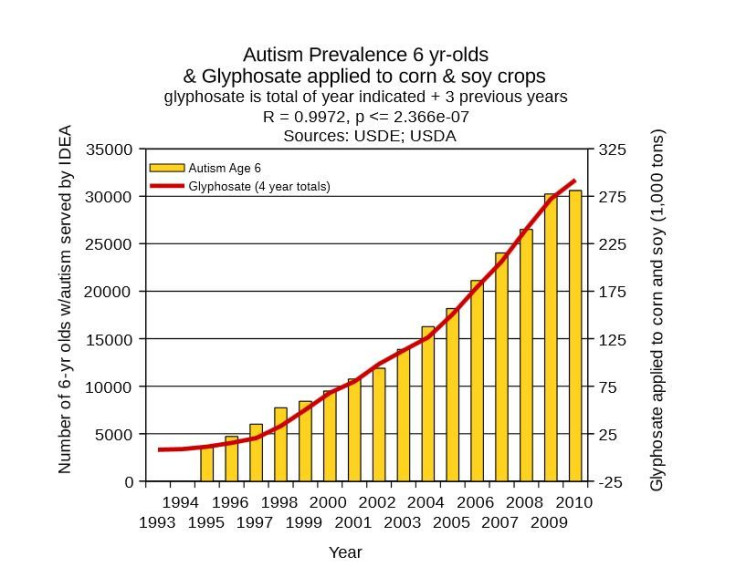Autism Rates To Increase By 2025? Glyphosate Herbicide May Be Responsible For Future Half Of Children With Autism

By 2025, half the children born in the United States will be diagnosed with autism, says Dr. Stephanie Seneff, a senior research scientist at the MIT Computer Science and Artificial Intelligence Laboratory. “Is there a toxic substance that is currently in our environment on the rise in step with increasing rates of autism that could explain this?” She asks in a 2013 presentation (video below) sponsored by Wellesley League of Women Voters. “The answer is yes, I’m quite sure that I’m right, and the answer is glyphosate.”
What is glyphosate?
Glyphosate, according to the Environmental Protection Agency, is a herbicide registered for use on a variety of fruit, vegetable, and field crops and widely used to control weeds. It is the active ingredient in RoundUp, a product made by Monsanto, which ranks as the number one herbicide worldwide. On the rise in China, RoundUp is a particular favorite in America, where genetically modified (GM) crops are bred to resist damage from the product — it kills the weeds, essentially, without hurting the GM plants.
According to Seneff, urine testing shows Americans have 10 times the glyphosate accumulation as Europeans. Even worse, the chemical is present in unusually high quantities in the breast milk of American mothers. Seneff refers to glyphosate as “a deceptively simple molecule” that kills by interrupting the shikimate pathway in weeds and other pest plants. Because our human cells don’t have this same pathway, scientists and researchers mistakenly assume glyphosate exposure is harmless to us. However, the flora residing in our intestines (where they help us digest food) do have a shikimate pathway, and so when glyphosate kills these beneficial bacteria, it harms our immune system. This science is explained in a paper, which Seneff wrote with co-author Anthony Samsel and appears in the online journal Entropy.
Naturally, whenever a scientist makes such damning claims of a particular product a rebuttal from the company will soon follow. “Many of the observations recorded in the paper were incorrect or poorly established,” states Glynn Young in a blog post for Monsanto. Young further notes the journal in which Seneff’s work is published is a physics journal, not a toxicology or medical journal, and that the study’s assertions are not backed up by the observations cited. Another scientist baldly states Seneff’s paper is “a load of crap.”
“Monika Krueger did some studies on cows and she found that after being fed a diet of glyphosate-laced feed over a long period, the cows had approximately equal amounts of glyphosate in their urine, feces, liver, kidney, lung and etc,” Dr. Nancy Swanson told Medical Daily in an email, “This clearly shows that glyphosate is being accumulated in the body.” In her 2014 study, Krueger also found that “chronically ill humans showed significantly higher glyphosate residues in urine than healthy population.” And glyphosate was significantly higher in urine of humans who ate conventional as opposed to organic foods.
Link to Autism?
“Glyphosate can explain health problems worldwide, including autism,” Seneff notes in her Wellesley lecture. “Autism is not a trivial thing to have, for those of you who know people who have children with autism — it can be a very severe disability.” She suggests various symptoms and signs common to children with autism — their zinc and iron deficiencies, for instance, and seizures — may be indicative of excessive glyphosate.
“The presence of glyphosate in our food is increasing and accumulates in our bodies over time,” Swanson told Medical Daily. She created this chart, which correlates the use of glyphosates and the prevalence of autism.

The EPA has set a deadline of 2015 for determining whether the use of glyphosate should be limited. Reuters reports Seneff’s controversial paper on the chemical has been submitted to the agency and will be included in its review.



























